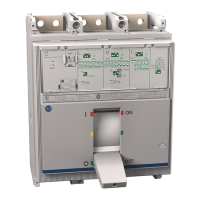(8)
DIR 1000587R0002 (Version 02)
2.4.1. Protection L
Protection L is the only adjustable protection that cannot be disabled since it provides self-protection against circuit-breaker
overloads.
- The type of curve setting is t=k/I
2
and the tripping time is calculated according to the value of If:
- For fault currents If 12ln, the tripping time of the protection is given by the expression: t(s)= . If the calculated value
is less than 1 second, the real tripping time is forced to 1 second (t(s)= 1s.)
- For fault currents If > 12ln, the tripping time is always t(s)= 1s.
NOTES:
- t(s)= estimated tripping time;
-I
f
= fault current; given in [In] (example: 0.7In)
-I
1
, t
1
= protection L parameters set by the user, given in [In] and [s]
Protection L has 3 operation conditions established by the primary current level I
f
and by the setting of the protection itself I
1
:
I
f
0.9 xI
1
No alarm, all settings possible. No time setting in progress.
0.9 xI
1
< I
f
< (1.05...1.2) xI
1
Prealarm L signal, all settings possible. No opening time setting in progress.
(1.05...1.2) xI
1
< I
f
Alarm L signal, no setting possible. Opening time setting in progress.
ATTENTION: the protection L threshold range ensures that:
- the trip unit is not in the alarm condition for current values below 1.05 xI
1
;
- the trip unit is in the alarm condition for current values over 1.2 xI
1.
2.4.2. Protection S
The protection, which can be disabled, can be the fi xed time (t=k) or inverse time (t=k/I
2
) type.
The tripping time with inverse time curve is given by the expression: t(s)= . If the calculated value is less than t
2
, the
real tripping time is forced to t
2
(t(s)= t
2
.)
NOTES:
- t(s)= estimated tripping time;
-I
f
= fault current; given in [In] (example: 1.7In)
-I
2
, t
2
= protection S parameters set by the user, given in [In] and [s]
2.4.3. Protection I
This protection can be disabled; it is of the fi xed time (t=k) type, and is designed for a nil intentional delay.
2.4.4. Protection G
The protection, which can be disabled, can be the fi xed time (t=k) or inverse time (t=k/I
2
) type.
The tripping time with inverse time curve is given by the expression: t(s)= ; If the calculated value is less than t
4
, the real
tripping time is forced to t
4
(t(s)= t
4
).
NOTES:
- t(s)= estimated tripping time;
-I
f
= fault current; given in [In] (example: 3.7In)
-I
4
, t
4
= protection G parameters set by the user, given in [In] and [s]
LSIG is able to provide Ground (Earth) fault protection, by vectorally adding together the phase and neutral currents. The fault
current is defi ned by the following formula:
If there is no fault in the circuit, I
G
= 0.
Vice versa, the fault current will acquire an increasingly higher value, depending on the entity of the fault.
ATTENTION: protection G is disabled for current values exceeding 8In (for I
4
0.8In), higher than 6In
(for 0.5In I
4
<0.8In) and higher than 4In (for I
4
<0.5In)
ATTENTION: in the absence of a separate supplied 24V DC voltage, the minimum threshold accepted is 0.25In
with rating plug= 400A and 0.2In for all the other sizes. If the entered value fails to comply with this limitation, the
SW overrides the threshold until it reaches the minimum value accepted and the LEDs display the “Inconsistent
settings” error.

